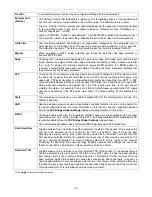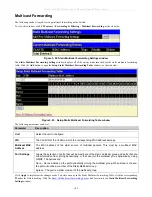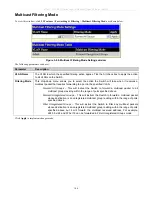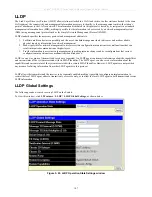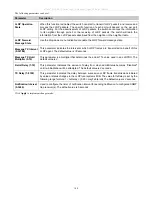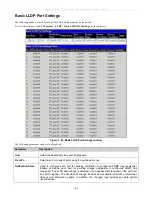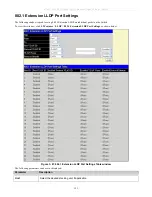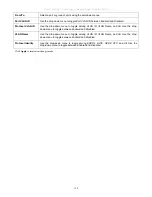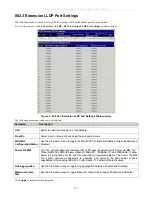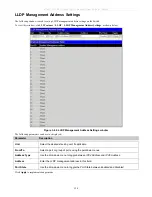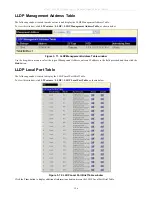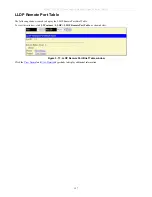
xStack
®
DGS-3600 Series Layer 3 Managed Gigabit Ethernet Switch
From/To
A consecutive group of ports may be configured starting with the selected port.
External Cost
(0=Auto)
This defines a metric that indicates the relative cost of forwarding packets to the specified port
list. Port cost can be set automatically or as a metric value. The default value is
0
(auto).
0 (auto)
- Setting
0
for the external cost will automatically set the speed for forwarding packets
to the specified port(s) in the list for optimal efficiency. Default port cost: 100Mbps port =
200000
. Gigabit port =
20000
.
value 1-200000000
- Define a value between
1
and
200000000
to determine the external cost.
The lower the number, the greater the probability the port will be chosen to forward packets.
Hello Time
The time interval between transmissions of configuration messages by the designated port, to
other devices on the bridged LAN. The user may choose a time between
1
and
10
seconds.
The default is
2
seconds. This field is only operable when the Switch is enabled for MSTP.
Migrate
When operating in RSTP mode, selecting yes forces the port that has been selected to
transmit RSTP BPDUs.
Edge
Choosing the
True
parameter designates the port as an edge port. Edge ports cannot create
loops, however an edge port can lose edge port status if a topology change creates a potential
for a loop. An edge port normally should not receive BPDU packets. If a BPDU packet is
received, it automatically loses edge port status. Choosing the
False
parameter indicates that
the port does not have edge port status.
P2P
Choosing the
True
parameter indicates a point-to-point (P2P) shared link. P2P ports are similar
to edge ports, however they are restricted in that a P2P port must operate in full duplex. Like
edge ports, P2P ports transition to a forwarding state rapidly thus benefiting from RSTP. A P2P
value of
False
indicates that the port cannot have P2P status.
Auto
allows the port to have P2P
status whenever possible and operate as if the P2P status were true. If the port cannot
maintain this status, (for example if the port is forced to half-duplex operation) the P2P status
changes to operate as if the P2P value were
False
. The default setting for this parameter is
True
.
State
This drop-down menu allows you to enable or disable STP for the selected group of ports. The
default is
Enabled
.
LBD
Use the pull-down menu to enable or disable the Loopback Detection function on the Switch for
the ports configured above. For more information on this function, see the Loopback Detection
field in the
STP Bridge Global Settings
window, mentioned earlier in this section.
BPDU
Choosing
Enabled
will allow the forwarding of BPDU packets in the specified ports from other
network devices. This will go into effect only if STP is globally disabled AND Forwarding BPDU
is globally enabled (See the
STP Bridge Global Settings
window above).
The default setting
Disabled
, does not forward BPDU packets when STP is disabled.
Restricted Role
Toggle between
True
and
False
to set the restricted role state of the packet. If
True
causes the
port not to be selected as the root port for the CIST or any MSTI, even if it has the best
spanning tree priority vector, such a port will be selected as an Alternate Port after the Root
Port has been selected. Setting this variable can cause lack of spanning tree connectivity. It is
set by a network administrator to prevent bridges external to a core region of the network
influencing the spanning tree active topology, possibly because those bridges are not under
the full control of the administrator. This parameter is
False
by default.
Restriced TCN
Toggle between
True
and
False
to set the restricted TCN of the packet. If
True
causes the port
not to be selected as the root port for the CIST or any MSTI, even if it has the best spanning
tree priority vector, such a port will be selected as an Alternate Port after the Root Port has
been selected. Setting this variable can cause lack of spanning tree connectivity. It is set by a
network administrator to prevent bridges external to a core region of the network influencing
the spanning tree active topology, possibly because those bridges are not under the full control
of the administrator. This parameter should be
False
by default.
Click
Apply
to implement changes made.
142















